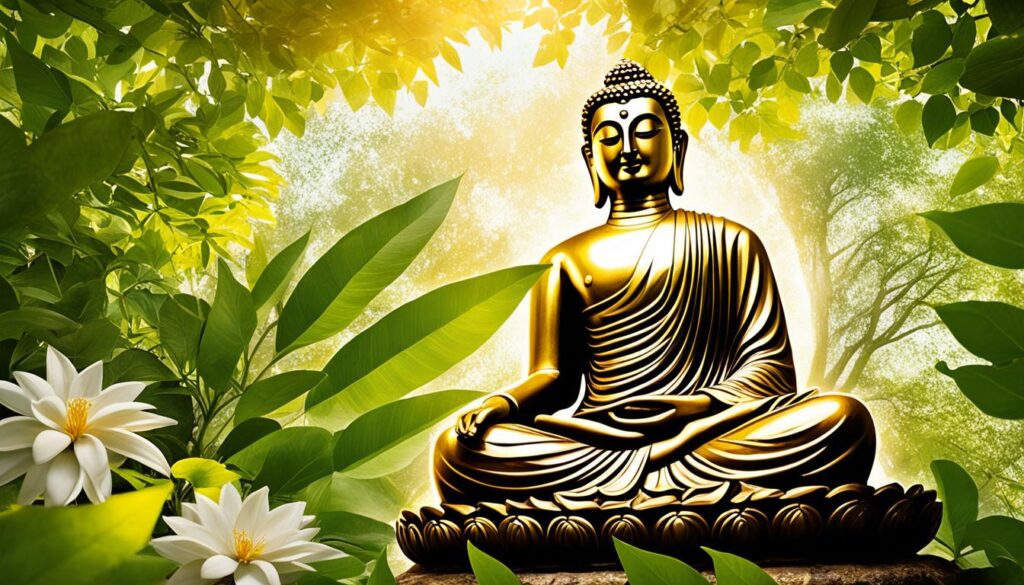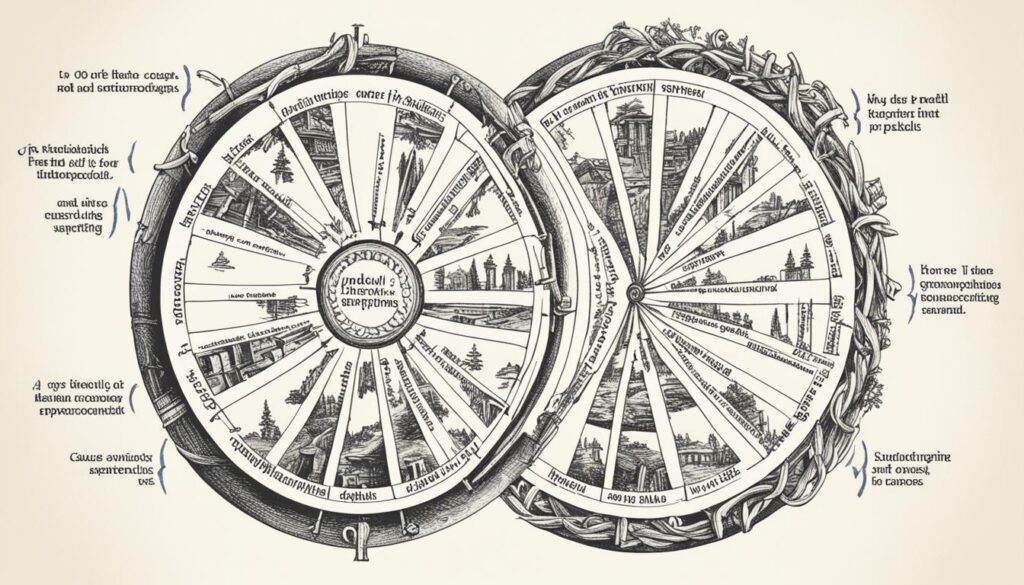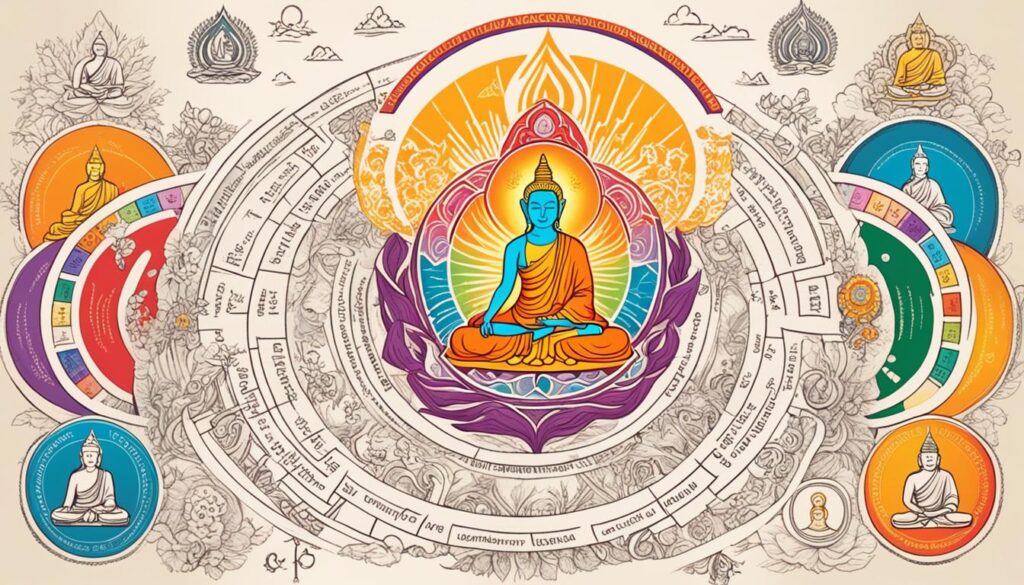“Thousands of candles can be lit from a single candle, and the life of the candle will not be shortened. Happiness never decreases by being shared.” – Buddha
Buddhism is a major global religion that offers a complex system of beliefs and practices. With its origins dating back to the 5th century B.C.E., Buddhism has evolved into various branches and traditions, each with its own emphasis and practices. Exploring the different types of Buddhism can help you find a spiritual path that resonates with your personal journey.
Key Takeaways:
- There are various branches and traditions within Buddhism, each with its own emphasis and practices.
- By exploring different types of Buddhism, you can find a spiritual path that resonates with your journey.
- Buddhism offers insights and techniques to cultivate inner peace and wisdom.
- Understanding the different types of Buddhism can deepen your knowledge of this ancient tradition.
- By immersing yourself in the various teachings and practices, you can find a path that aligns with your values and aspirations.
The Basics of Buddhism: The Life of Siddhartha Gautama
Siddhartha Gautama, the founder of Buddhism, was born in the 5th century B.C.E. He was the son of an Indian warrior-king and lived an extravagant life until he became dissatisfied with the world’s pleasures and sought understanding. After witnessing the suffering of humanity, he renounced his princely title and became a monk.
Through meditation, he achieved enlightenment and became known as the Buddha. The teachings of the Buddha form the foundation of Buddhism.
Let’s take a closer look at the life of Siddhartha Gautama and how his journey led to the birth of one of the world’s most influential religions.
The Early Years of Siddhartha Gautama
Siddhartha Gautama was born into the Kshatriya warrior caste in a region that is now part of Nepal. His father, King Suddhodana, wanted to protect him from the suffering of the world, so he provided Siddhartha with a life of luxury and privilege.
However, Siddhartha was deeply affected by encounters with old age, illness, and death. These experiences made him question the nature of existence and the meaning of life.
The Path to Enlightenment
Dissatisfied with his life of luxury, Siddhartha ventured out of the palace walls and encountered an ascetic, a wandering holy man. Inspired by the ascetic’s peaceful demeanor, Siddhartha decided to leave his princely life behind and search for spiritual truth.
For six years, Siddhartha practiced extreme asceticism and meditation. He subjected himself to severe physical deprivation and pushed the limits of his body and mind in pursuit of enlightenment.
The Awakening of a Buddha
One day, while meditating under a Bodhi tree, Siddhartha finally achieved enlightenment. He gained insight into the nature of suffering and the path to liberation from it.
Having attained enlightenment, Siddhartha became the Buddha, meaning “the awakened one.” He dedicated the rest of his life to teaching others the path to enlightenment and helping them alleviate suffering.

The Legacy of Siddhartha Gautama
The life of Siddhartha Gautama, the Buddha, left a lasting impact on the world. His teachings, known as the Dharma, form the basis of Buddhism’s philosophy and practices.
The Buddha’s teachings focus on the attainment of Nirvana, the ultimate goal in Buddhism, which represents the end of suffering and the liberation from the cycle of rebirth. Through mindfulness, ethical conduct, and meditation, followers of Buddhism strive to reach this state of awakening.
| Key Concepts | Description |
|---|---|
| The Four Noble Truths | The truth of suffering, the cause of suffering, the end of suffering, and the path that leads to the end of suffering. |
| The Noble Eightfold Path | The path to liberation from suffering, consisting of ethical conduct, mental discipline, and wisdom. |
| Karma | The idea that one’s actions have consequences, shaping one’s present and future experiences. |
| Rebirth | The belief in the cycle of birth, death, and rebirth, with the opportunity to break free through enlightenment. |
The life of Siddhartha Gautama, the Buddha, serves as an inspiration for millions of people who seek meaning, inner peace, and liberation from suffering. Through his teachings, he invites individuals to embark on a transformative spiritual journey, discovering their own path to enlightenment.
The Four Noble Truths: The Essence of Buddha’s Teachings
The Four Noble Truths form the foundation of Buddhist teachings. They offer profound insights into the nature of existence and provide a roadmap for transcending suffering and attaining enlightenment.
The First Noble Truth: Acknowledging the Existence of Suffering
The First Noble Truth acknowledges the reality of suffering in our lives. It reminds us that suffering is an inherent part of the human experience and that its presence is universal. Whether it’s physical pain, emotional distress, or the dissatisfaction that arises from constant craving, suffering encompasses various forms and permeates our existence.
The Second Noble Truth: Identifying the Root Causes of Suffering
The Second Noble Truth elucidates the causes of suffering—desire and ignorance. It recognizes that our attachment to desires, cravings, and expectations, coupled with ignorance of the true nature of reality, fuels our suffering. By clinging to impermanent phenomena and clinging to ideas of self, we perpetuate a cycle of craving and dissatisfaction.
The Third Noble Truth: Discovering the End of Suffering
The Third Noble Truth brings hope by asserting that suffering can be overcome. It proclaims that the end of suffering is attainable through the achievement of Nirvana, a state of liberation, and transcendence. By liberating ourselves from the illusions of desire and ignorance, we can experience true contentment and freedom from suffering.
The Fourth Noble Truth: Embarking on the Path to the End of Suffering
The Fourth Noble Truth presents the Noble Eightfold Path, which serves as a guide to end suffering and achieve enlightenment. This path consists of eight interrelated aspects—Right Understanding, Right Intention, Right Speech, Right Action, Right Livelihood, Right Effort, Right Mindfulness, and Right Concentration. These factors dictate a balanced and ethical way of living, leading to the cessation of suffering and the realization of enlightenment.

By diligently practicing the Noble Eightfold Path, individuals can cultivate wisdom, moral discipline, and mental clarity, ultimately transcending suffering and attaining enlightenment.
| Noble Truth | Description |
|---|---|
| First Noble Truth | Acknowledges the existence of suffering in life |
| Second Noble Truth | Identifies desire and ignorance as the root causes of suffering |
| Third Noble Truth | Offers hope by stating that suffering can end through achieving Nirvana |
| Fourth Noble Truth | Outlines the Noble Eightfold Path, providing guidance on how to attain the end of suffering |
Karma and Rebirth: The Cycle of Cause and Effect
Buddhism teaches the fundamental concept of karma, which emphasizes the importance of cause and effect in our lives. Karma refers to the consequences, both positive and negative, that result from our actions and intentions. Every thought, word, and deed contributes to the accumulation of karma, shaping our present experiences and influencing our future lives.
Good actions lead to positive outcomes and happiness, while bad actions lead to suffering and negative consequences. This cycle of cause and effect is inherent in the law of karma, governing the conditions of our existence. It is a reminder that our choices and behaviors have far-reaching implications and impact not only ourselves but also the world around us.
The cycle of rebirth is closely tied to the concept of karma. According to Buddhism, our karma determines our next rebirth, as we continuously move through the cycle of birth, life, death, and rebirth. Depending on the quality of our actions, we may find ourselves reborn in higher or lower realms, experiencing the consequences of our past deeds.
The ultimate aim in Buddhism is to break free from this cycle of rebirth by achieving enlightenment and attaining Nirvana. Through spiritual practice and self-transformation, individuals can purify their karma and liberate themselves from the endless cycle of suffering. By understanding the interconnectedness of all actions and their effects, we gain the power to shape our destiny and create a more positive and compassionate world.

This image depicts the cycle of rebirth, depicting the interconnectedness of cause and effect. It serves as a visual representation of the ongoing process of karma and rebirth in Buddhism.
The Three Schools of Buddhism: Mahayana, Theravada, and Vajrayana
Buddhism encompasses three main schools, each offering a unique path to spiritual enlightenment. These schools are Mahayana, Theravada, and Vajrayana. Let’s explore the distinctive characteristics and practices of each school:
Mahayana Buddhism
Originating in East Asia, Mahayana Buddhism emphasizes compassion, wisdom, and the aspiration to become a bodhisattva—a being dedicated to helping others attain enlightenment. Mahayana practitioners believe in the potential for all sentient beings to achieve Buddhahood. The school encourages engagement with the world and the cultivation of virtues such as loving-kindness and compassion for all beings.
Theravada Buddhism
Theravada Buddhism, predominantly practiced in Southeast Asia, focuses on the original teachings of the Buddha and follows the Pali Canon. This school emphasizes the monastic lifestyle and the practice of meditation as a path to liberation. Theravada practitioners strive to attain enlightenment through mindfulness, insight, and disciplined living. They view the Buddha as a historical figure and aim to follow his teachings closely.
Vajrayana Buddhism
Vajrayana Buddhism, prevalent in Tibet and the Himalayan region, offers an accelerated path to enlightenment. It incorporates tantric practices and rituals, aiming to transform ordinary experiences into opportunities for spiritual growth. Vajrayana practitioners utilize a range of methods, including deity yoga, mantra recitation, and visualization, to achieve awakening in a shorter time frame. This school places great importance on the guidance of a qualified teacher.
Although the three schools share the ultimate goal of liberation from suffering, they vary in their approaches and emphases. For a better understanding, refer to the table below:
| School | Geographic Region | Main Emphasis | Practices |
|---|---|---|---|
| Mahayana | East Asia | Compassion and bodhisattva path | Chanting, meditation, sutra study, bodhisattva practices |
| Theravada | Southeast Asia | Early Buddhist teachings and monastic lifestyle | Meditation, mindfulness, ethical conduct, monastic discipline |
| Vajrayana | Tibet, Himalayan region | Accelerated enlightenment through tantric practices | Deity yoga, mantra recitation, visualization, ritual practices |

By understanding the distinctions and unique aspects of Mahayana, Theravada, and Vajrayana Buddhism, individuals can explore which school resonates with their spiritual aspirations. Each offers a rich and meaningful approach to the path of awakening, guiding practitioners towards liberation from suffering and the cultivation of wisdom and compassion.
Buddhism in the Modern World: Challenges and Adaptations
Buddhism, originating thousands of years ago, has withstood the test of time by adapting to the ever-changing modern world. In today’s fast-paced and interconnected society, Buddhism faces various challenges that require innovative approaches and adaptations. The integration of Buddhist teachings into daily life has become necessary to address contemporary issues and promote personal well-being, societal harmony, and positive change.
Contemporary challenges often arise from the demands and complexities of modern life. The constant pressures of work, technology, and social expectations can impede one’s ability to find peace and contentment. In response, Buddhists are exploring ways to adapt traditional practices to suit the needs of individuals in the modern world.
One contemporary challenge is the need to promote mindfulness and compassion amidst the distractions and busyness of everyday life. Mindfulness, a core practice in Buddhism, offers a way to cultivate present-moment awareness and non-judgmental acceptance. By integrating mindfulness into daily routines, individuals can develop a greater sense of inner calm and clarity.
The adaptation of Buddhism also involves tackling pressing social and environmental issues. Many Buddhist communities are actively engaging in initiatives to address poverty, inequality, environmental degradation, and climate change. By embracing compassion, Buddhists strive to create a more equitable and sustainable world for present and future generations.
Adapting Buddhism in a Pluralistic Society
In a diverse and multicultural society, Buddhists are exploring ways to engage with people from different backgrounds and belief systems. The teachings of Buddhism, with their focus on compassion and understanding, can bridge cultural and religious divides, promoting interfaith dialogue and fostering mutual respect.
Moreover, the adaptation of Buddhism involves making it accessible and relevant to individuals from all walks of life. By presenting Buddhist teachings in a language and context that resonate with diverse communities, Buddhism can reach a wider audience and offer its wisdom to those seeking guidance in navigating life’s challenges.
Overall, Buddhism’s teachings remain timeless and universal, providing individuals with insights and practices that can help them find personal and societal harmony in the face of modern challenges. By adapting to the needs of the modern world and embracing contemporary issues, Buddhism continues to inspire and guide individuals on their spiritual journeys.
| Contemporary Challenges | Adaptations |
|---|---|
| Mindfulness amidst distractions | Integration of mindfulness into daily life |
| Social and environmental problems | Engagement in initiatives to address social and environmental issues |
| Engaging with diverse communities | Promoting interfaith dialogue and cultural understanding |
| Relevance to all walks of life | Presenting teachings in a language and context that resonate with diverse communities |
Finding Your Path: Exploring Different Types of Buddhism
Embarking on a journey of Buddhist exploration allows you to discover a spiritual path that resonates with your unique quest for enlightenment. The diverse practices and traditions within Buddhism offer a rich tapestry of insights, techniques, and wisdom to guide you on this transformative journey.
Within the expansive world of Buddhism, you can find various paths tailored to different inclinations and aspirations. Let’s delve into three prominent Buddhist traditions that exemplify the breadth of this ancient philosophy:
Meditation-Focused Theravada Tradition
The Theravada tradition, practiced mainly in Southeast Asia, emphasizes the power of meditation and personal introspection. Through disciplined meditation practices, Theravada Buddhists cultivate mindfulness and insight, seeking to gain a deep understanding of the nature of reality and liberate themselves from suffering.
The Theravada path encourages individuals to develop qualities such as wisdom, compassion, and ethical conduct. By following the Noble Eightfold Path, which encompasses right view, intention, speech, action, livelihood, effort, mindfulness, and concentration, practitioners strive for self-realization and the highest form of awakening, known as Nirvana.
Compassionate Mahayana Approach
Mahayana Buddhism, widely practiced in East Asia, emphasizes compassion and the aspiration to attain enlightenment not only for oneself but for all sentient beings. In this tradition, bodhisattvas are revered as enlightened beings who have chosen to delay their entry into Nirvana to alleviate the suffering of others.
Mahayana Buddhists believe that compassion and wisdom are interdependent. Hence, they embark on the cultivation of wisdom through meditation practices and the development of compassion through acts of kindness, charity, and serving others. This tradition promotes the ideal of the bodhisattva, inspiring individuals to dedicate themselves to the welfare of all beings.
Transformative Practices of Vajrayana
Vajrayana, practiced in Tibet and the Himalayan region, offers a transformative path that combines meditation, visualizations, rituals, and mantra recitations. Vajrayana serves as an accelerant to attaining enlightenment by employing the creative and energetic forces of the mind and emotions as vehicles for awakening.
This tradition places great emphasis on the relationship between student and teacher, as well as on esoteric practices and deity yoga. Through the practice of tantra, Vajrayana Buddhists aim to transcend ordinary dualistic perceptions and access the innate wisdom and compassionate energy within themselves.
By immersing yourself in these diverse Buddhist practices, you gain a holistic understanding of the human experience and discover profound techniques to cultivate inner peace, wisdom, and compassion. Let us now summarize the key features of these traditions in a table:
| Tradition | Focus | Methods | Goal |
|---|---|---|---|
| Theravada | Meditation and introspection | Noble Eightfold Path | Self-realization and Nirvana |
| Mahayana | Compassion for all beings | Meditation and acts of kindness | Enlightenment for the benefit of all |
| Vajrayana | Transformative practices and rituals | Tantric techniques and deity yoga | Awakening through the union of wisdom and compassion |
As you explore these different types of Buddhism, you will uncover profound teachings, practices, and insights that resonate with your values and aspirations. Each tradition offers a unique path to spiritual growth and self-discovery. Embrace the diversity of Buddhist practices, and embark on a transformative journey of self-realization and enlightenment.
Conclusion
Buddhism is a rich and diverse religion that holds the potential for profound personal and societal transformation. By delving into the various types of Buddhism, you can unlock a deeper understanding of the teachings, practices, and philosophy that underpin this ancient tradition. From cultivating mindfulness and compassion to navigating contemporary challenges, Buddhism offers invaluable insights and guidance for leading a life of meaning and fulfillment.
Take the time to explore the different branches and traditions of Buddhism to find the path that resonates with your innermost journey. Whether you are drawn to the serene meditation-focused practices of Theravada or the compassionate approach of Mahayana, each tradition offers unique techniques to cultivate inner peace and wisdom. The transformative practices of Vajrayana may also captivate you, offering a faster route to enlightenment through its incorporation of tantric methods. Discover the profound connection to Buddhism that aligns with your values and aspirations.
Through its timeless wisdom and adaptable nature, Buddhism transcends cultural and temporal boundaries. It continues to inspire individuals to lead purposeful lives, unlock their true potential, and find harmony in an ever-changing world. So, embark on your exploration of Buddhism, embrace its teachings, and forge a path that resonates with your spiritual journey. May your endeavors be guided by the profound insights and principles of this ancient tradition, leading you to lasting happiness and fulfillment.
FAQ
What is Buddhism?
Buddhism is a major global religion that originated in the 5th century B.C.E. with Siddhartha Gautama, known as the Buddha. It offers a complex system of beliefs and practices.
Who was Siddhartha Gautama?
Siddhartha Gautama was the founder of Buddhism. He was born in the 5th century B.C.E. and renounced his princely title to become a monk. Through meditation, he achieved enlightenment and became known as the Buddha.
What are the Four Noble Truths?
The Four Noble Truths are the core teachings of the Buddha. They describe the truth of suffering, the cause of suffering, the end of suffering, and the path that leads to the end of suffering.
What is karma?
Karma is a fundamental concept in Buddhism that refers to the consequences of one’s actions. Good actions lead to happiness and positive outcomes, while bad actions lead to suffering and negative consequences.
What is the cycle of rebirth?
The cycle of rebirth is a central belief in Buddhism, where individuals are continuously reborn into different bodies based on their karma. The aim is to break free from this cycle by achieving enlightenment and attaining Nirvana.
What are the three main schools of Buddhism?
The three main schools of Buddhism are Mahayana, Theravada, and Vajrayana. Each school has its own emphasis and practices, such as the role of bodhisattvas, meditation, and tantric practices.
How has Buddhism adapted to the modern world?
Buddhism has adapted to the modern world by integrating its teachings into daily life, addressing contemporary issues, promoting mindfulness and compassion, and engaging with diverse communities.
How can I find my spiritual path in Buddhism?
By exploring the different types of Buddhism and immersing yourself in their teachings and practices, you can find a path that resonates with your values and aspirations.

